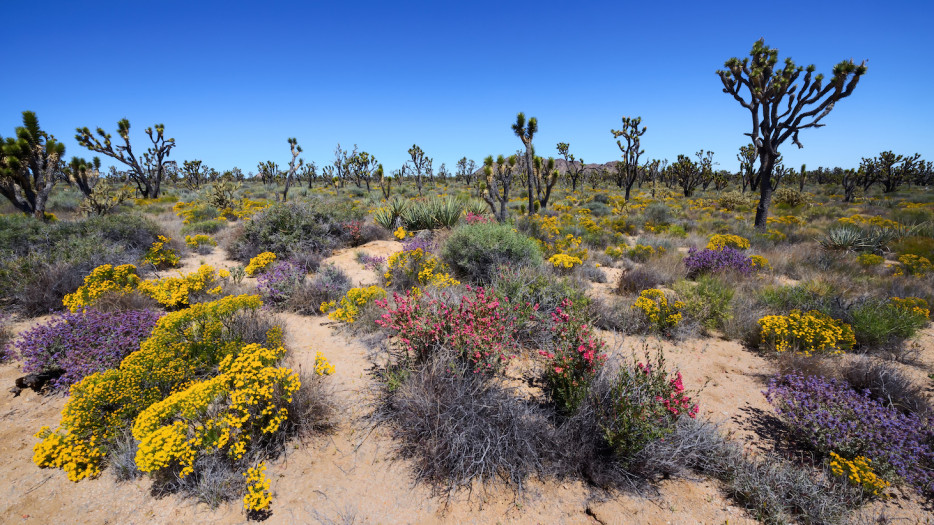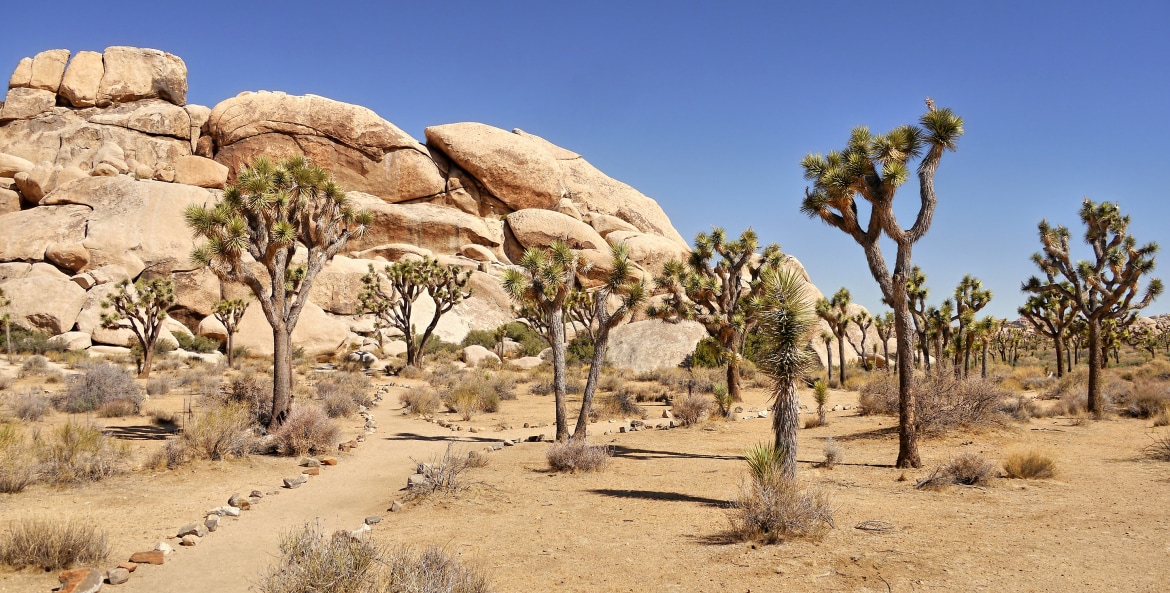Sandwiched between two highways connecting Las Vegas with Los Angeles, the Mojave National Preserve offers the kind of scenery and adventure you’d expect from a national park—without the crowds or entry fee.
Mojave National Preserve covers roughly 1.6 million acres, bordered by I-15 to the north and I-40 to the south, making it one of the largest areas in the country administered by the National Parks Service. It boasts the second biggest sand dune system in California and more Joshua Trees than Joshua Tree National Park.
In addition to the many outdoor activities—including hiking and 4-wheeling—that draw people to the preserve, Mojave has rich cultural significance to the southwest United States. Long the home of the Chemehuevi, the area became a thoroughfare for European settlers and then a hotbed of mining activity in the 1880s. Gold, silver, copper, and iron brought floods of people and swift development. Buildings that once provided lodging and food for miners and railroad employees are now used as a visitors’ center and desert-studies facility.
While you might not think much of the desolate-looking landscapes seen from the highway, the Mojave National Preserve can reward those who take time to explore the colorful floral displays, spectacular sunsets, uncrowded hiking trails, and the kind of quiet beauty only found in the desert.

Don’t miss a trip to the towering Kelso sand dunes.
Top Attractions in Mojave National Preserve
For most visitors, the great appeal of the Mojave National Preserve is its apparent emptiness: Here, you can experience a peaceful isolation that’s hard to come by in our hyper-connected world. But there are some sights worthy of a traveler’s checklist, too.
Evidence of the area’s volcanic past is everywhere, including in an underground lava tube in the Cinder Cones National Natural Landmark. Teutonia Peak is the highest point of the Cima volcanic field, a huge area of ancient lava flows and numerous volcanic cones that you can climb. That’s also where you’ll see dense forests of Joshua Trees.
The Kelso Dunes occupy 45 square miles of the Mojave, rising to a height of 650 feet at their tallest points. Depending on the season, different parts of the preserve may be awash in color. Showy fields of wildflowers blanket not only the desert floor but also, sometimes, the dunes and hillsides.
The otherworldly rock formations inside the Mitchell Caverns are open to visitors on guided tours. And, of course, there are plenty of trails for hiking and horseback riding, and miles of challenging 4-wheel driving routes.

The preserve is far from a barren desert.
Where to Go and What to Do
The Mojave National Preserve lacks the abundant visitor facilities of a national park, but if you come prepared you won’t miss them. Always bring plenty of water, heed weather warnings, and be sure to leave the area just as you found it.
Kelso Ghost Town
Start your Mojave adventure in the ghost town of Kelso, where the former train depot now serves as the main visitor center. It also contains a small art gallery and museum.
4-Wheel Drive Routes
The emptiness of the Mojave National Preserve—not to mention the thousand-plus miles of off-road driving routes—makes it popular with riders of 4x4s. Drivers test their skills (and vehicles) over rough terrain, leading to areas not accessible to anyone sticking to pavement.
Hiking
Hikers have a few established trails to choose from, as well as several more unmarked trails that are well-loved by experienced hikers. Many of the latter trailheads can only be reached by 4-wheel drive. Developed hikes range from the easy Lake Tuendae Nature Trail or Hole-in-the-Wall Nature Trail to the more challenging trails up Teutonia Peak or the Kelso Dunes.
Cima Volcanic Field
The 1.5-mile hike to the top of Teutonia Peak is tougher than its distance would suggest, gaining some 750 feet of elevation, but the summit rewards those who persevere with 360-degree views. Even if you don’t want to tackle the hardest part of the hike, it’s worth hiking through the easier beginning part of the trail to see the incredible Joshua Tree forest.
Kelso Dunes
Not only does a hike up to the top of the highest of the Kelso Dunes offer a great workout and unique perspective on the area, it’s also an ideal spot for watching the sunrise or sunset.
Cinder Cones National Natural Landmark
This landmark, entirely inside the preserve, has dozens of volcanic cones (remnants of ancient lava flows). There’s one lava tube that visitors can climb inside.
Providence Mountains State Recreation Area
Another enclave inside the preserve, this recreation area’s main attraction is the Mitchell Caverns. The caves are accessible by guided tours only, which include a somewhat difficult hike to the entrance of the caves plus the one-hour caverns tour.
Wildlife
Even in an empty-looking desert, wildlife is everywhere. Look for bighorn sheep and roadrunners, as well as desert tortoises that dig burrows to escape the heat. The Mojave is also home to the Chuckwalla, a lizard that can grow up to 16 inches in length.

Wildflowers paint the desert each spring.
Where to Camp
There are two established campgrounds inside the preserve—Mid Hills and Hole-in-the-Wall. The former sits at 5,600 feet and has 26 campsites, while the latter has 35 campsites at 4,400 feet. Both campgrounds have some picnic tables, trash bins, fire rings, and pit toilets. Neither currently has potable water, so be sure to check the official Mojave website for updates and plan to bring your own water.
Roadside camping options are plentiful, too, though the NPS requires visitors to reuse existing camping sites to limit further damage to the landscape. In other words, if you see a fire ring, it’s an acceptable roadside camping spot.
Seasonal Considerations and Best Times of Year to Visit
High temperatures from June through August are well over 100F, and triple-digit highs often pop up in May and September, too. On the other end of the calendar, winter can bring strong wind gusts and, at higher elevations, snow.
The best times of year to visit the Mojave National Preserve are spring and fall. March and April typically offer the best chance of seeing the wildflower carpets in bloom, while the autumn months still enjoy mild temperatures with fewer visitors.
Even during the most desirable times of year for a trip, the desert can bring unpredictable weather—including high winds and sudden thunderstorms. Not only that, some attractions or activities may be closed or limited depending on the season. It’s always best to check the official website or ask at the visitor center upon arrival for the most current information.
